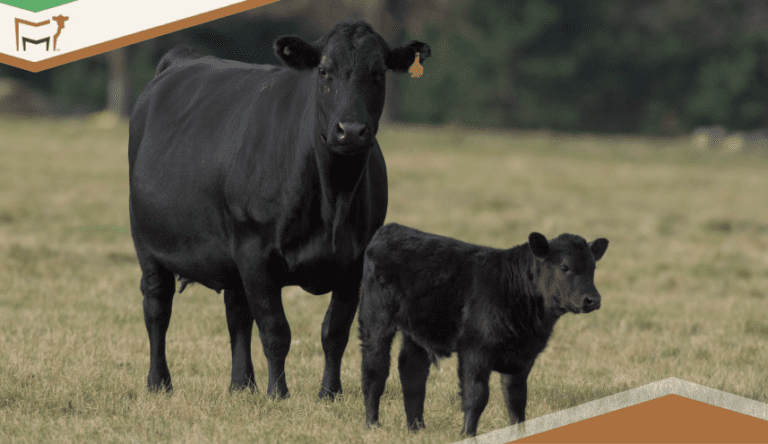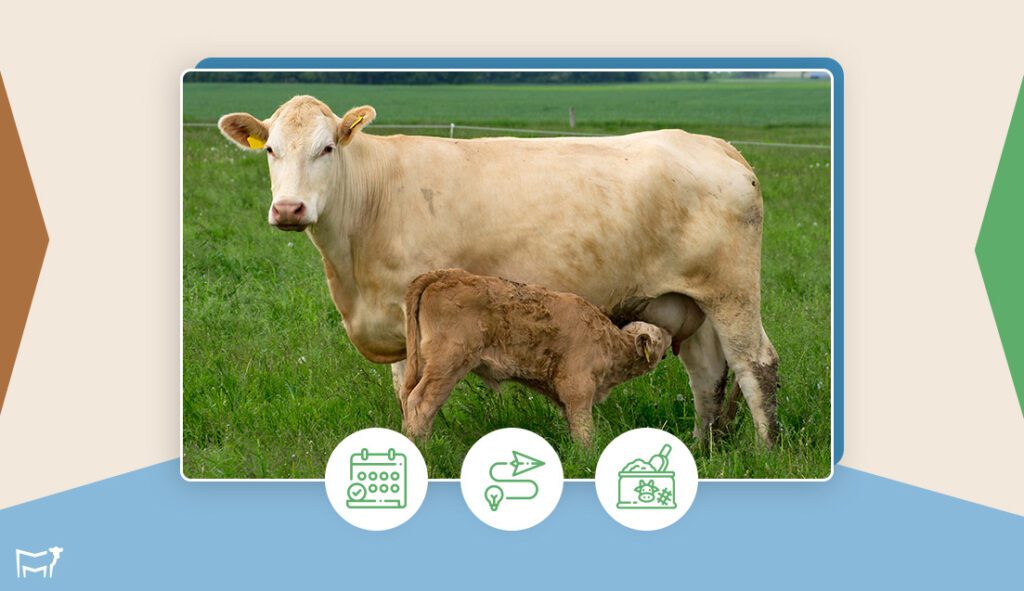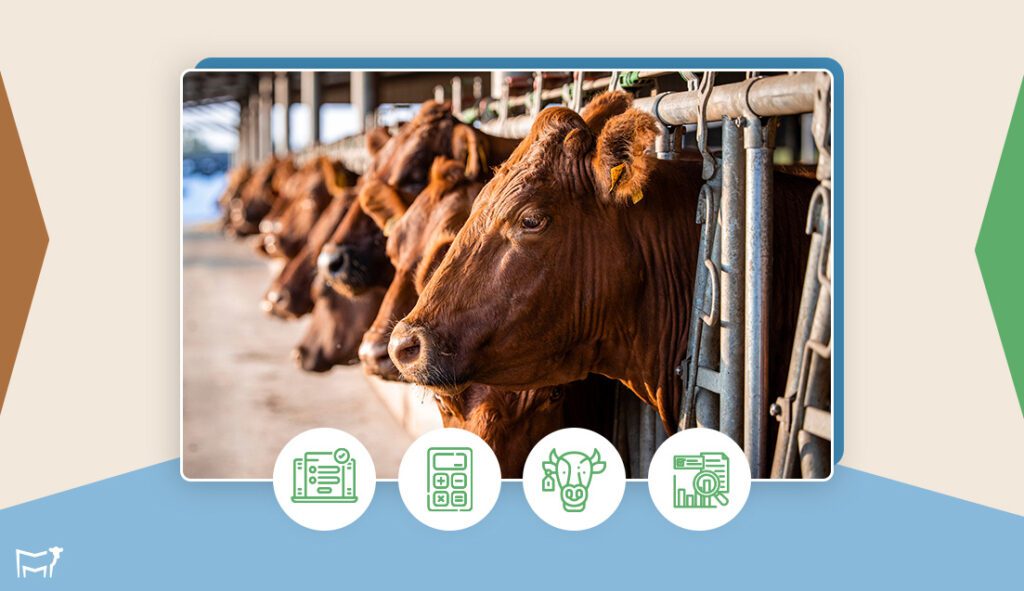Understanding Cattle Gestation: A Comprehensive Guide for Ranchers

The gestation period in cattle refers to the length of time a cow carries her calf from conception to birth. It typically lasts 283 days and is calculated starting from the date of breeding or artificial insemination.
Understanding the gestation period enables ranchers to make informed decisions about breeding schedules, herd composition, and resource allocation. Understanding its impact on milk production helps in planning for production cycles and managing the herd’s overall output.
So let’s read more about how to calculate the gestation period, the factors affecting it, how to keep records of gestation stages, etc.
How is the Gestation Period in Cattle Calculated?
Most producers calculate a cow’s due date by counting forward 283 days from the breeding date. Another way to do it is to subtract 82 days from the breeding date and then add a year. Either method gives you a good estimate for calving.
Many ranchers use gestation calendars designed for cattle. These let you pinpoint the expected calving date just by entering the breeding date. Gestation wheels, which are simple circular calculators, do the same thing, giving you breeding and calving dates at a quick glance.

Different breeds of cattle have slightly different gestation periods. For example, Angus cows usually have a gestation of about 283 days, while the Limousin breed tends to go a bit longer, closer to 291 days. Of course, individual cows might calve a little earlier or later than average.
Factors Affecting the Gestation Period
It’s best not to interfere with a cow’s natural gestation period, since it’s ideal for the calf’s development. Understanding what influences gestation can help you better predict calving and manage your herd. The focus should always be on giving the cow the best conditions during pregnancy, rather than trying to change how long the gestation lasts.
Breed
The influence of breed on gestation length is a significant factor in cattle reproduction. Different breeds have evolved with their own unique gestation periods thanks to genetics and selective breeding over time.
While you can’t change a breed’s natural gestation period, you can choose breeds that fit your operation’s needs. For example, some ranchers plan calving seasons around favorable weather or market timing. Knowing the gestation length of your cattle allows for better preparation and potentially reduces complications during birth.
Calf Gender
The impact of calf gender on gestation length, while subtle, is a fascinating aspect of bovine reproduction. Male calves typically have a gestation period that is 1-2 days longer than female calves. This slight difference is believed to be related to the hormonal influences of the developing fetus on the maternal endocrine system.
The exact mechanisms are not fully understood, but it’s thought that male fetuses may produce hormones that slightly prolong gestation. While this factor cannot be controlled in natural breeding, the use of sexed semen in artificial insemination can influence the likelihood of conceiving male or female calves.
However, the minimal difference in gestation length due to gender is generally not a significant consideration in most farming operations. Instead, it’s more of a biological curiosity that demonstrates the complex interplay between fetal development and maternal physiology in determining the precise timing of birth.
Age of the Cow
The age of the cow plays a notable role in gestation length, with a general trend of shorter gestation periods in first-time mothers (heifers) compared to older, more mature cows. This phenomenon is likely due to a combination of physiological and hormonal factors.
Heifers’ bodies are still developing, and they may not have the same capacity to support fetal growth for as long as mature cows. Additionally, hormonal differences between heifers and older cows might influence the timing of labor onset. As cows age and have multiple pregnancies, their reproductive system becomes more efficient, potentially leading to slightly longer gestation periods.
This natural progression shouldn’t be artificially controlled but rather understood and incorporated into herd management strategies. Farmers often provide extra attention to heifers during their first pregnancy and calving, anticipating potential complications and the possibility of slightly earlier births. Understanding this age-related variation helps in more accurate calving date predictions and appropriate care planning for different age groups within the herd.
Nutritional Status
The nutritional status of a pregnant cow is a critical factor that can significantly influence gestation length and overall reproductive success.
Proper nutrition during pregnancy is essential for both the cow’s health and the optimal development of the fetus. Undernourished cows may experience shorter gestation periods, as the body may trigger early labor in response to inadequate resources for fetal growth. This can result in underweight calves with reduced survival rates. Conversely, over-conditioned cows might have longer gestation periods, potentially leading to oversized calves and an increased risk of dystocia (difficult birth).
In early pregnancy, nutritional requirements are similar to maintenance levels. However, as the fetus grows rapidly in the last trimester, nutritional needs increase significantly. Farmers should adjust feed rations accordingly, considering factors such as forage quality, body condition score, and environmental conditions.
Proper nutritional management can help ensure that gestation lengths remain within the optimal range for the breed. This not only supports the health of the cow and calf but also contributes to better postpartum recovery and subsequent reproductive performance.
Sire Effect
Sire Effect: The sire, or father, of the calf, can have a notable influence on gestation length, a phenomenon known as the sire effect. This effect is due to the genetic contribution of the bull to the developing fetus. Some bulls consistently sire calves with longer or shorter gestation periods compared to the breed average, regardless of the dam (mother) involved.
The sire effect on gestation length is believed to be related to genes that influence fetal growth rate and the timing of signals for the initiation of parturition (birth). Bulls that tend to sire larger calves may also be associated with longer gestation periods, as the fetus may require more time to reach full development.
This factor can be partially controlled through careful sire selection in breeding programs. Farmers and breeders can use historical data on a bull’s offspring to predict the likely gestation length of future calves. Expected Progeny Differences (EPDs) for gestation length are available for some breeds, providing a valuable tool for sire selection.
However, like other genetic factors, the sire effect on gestation length should be considered in balance with other important traits. A bull that consistently sires calves with shorter gestation periods might be desirable for reducing calving difficulties, but this should be weighed against other factors such as growth potential, carcass quality, and overall genetic merit.
3 Stages of Gestation
The stages of gestation in cattle are divided into three trimesters, each lasting about three months.
First trimester
During the first trimester, which spans from conception to about 3 months, early embryonic development occurs and the placenta forms.
Ranchers and farmers should focus on confirming pregnancy through veterinary checks and maintaining normal nutrition levels. It’s crucial to avoid stressing the animals during this period while continuing regular vaccinations and health checks. This is also the time to plan ahead for the entire gestation period.
Second trimester
In the second trimester, from 3 to 6 months, rapid fetal growth begins and fetal organs develop and become functional. During this stage, ranchers should monitor body condition scores and adjust feed as necessary.
They should continue regular health checks and begin preparations for the upcoming calving season. This is a good time to consider administering any mid-gestation vaccinations recommended by a veterinarian and ensure adequate vitamin and mineral supplementation.
Third trimester
The third trimester, from 6 to 9 months, is characterized by significant fetal weight gain and size increase, along with final development and preparation for birth.
Ranchers need to significantly increase nutrition to support rapid fetal growth and prepare the cow for lactation. Close monitoring for any signs of health issues is crucial. As the due date approaches, pregnant cows should be moved to calving areas. This is the time to prepare calving equipment and supplies, increase the frequency of observation, and ensure colostrum is available for newborn calves.
Throughout all stages of gestation, maintaining a clean, stress-free environment and providing access to fresh, clean water at all times is essential. Keeping accurate records of breeding dates and expected calving dates helps in proper management.
Impact on Milk Production

During pregnancy, a dairy cow’s body undergoes
The most notable impact occurs during the last trimester of pregnancy. Milk yield typically begins to decrease around the 5th to 7th month of gestation. This decline is due to several factors:
1. Nutrient Partitioning: The cow’s body begins to prioritize nutrients for fetal growth and development over milk production. Essential nutrients are redirected from milk synthesis to support the rapidly growing fetus.
2. Hormonal Changes: Pregnancy hormones, particularly estrogen and progesterone, increase as gestation progresses. These hormones can inhibit milk production.
3. Mammary Gland Remodeling: The udder tissue begins to prepare for the next lactation cycle, which involves some regression of milk-producing cells.
The extent of milk production decline varies among individual cows but can range from 20% to 40% by the end of lactation. High-producing cows often experience a more dramatic decline compared to low producing cows.
Keeping Accurate Records of Cattle Gestation
Proper record-keeping allows ranchers and farmers to track individual cow performance, predict calving dates, manage breeding programs, and make informed decisions about herd health and productivity.
Traditionally, ranchers have used various methods for record-keeping, including handwritten logbooks, spreadsheets, or basic computer programs. These records typically include information such as:
1. Cow identification (tag number or name)
2. Breeding date
3. Bull used for breeding
4. Expected calving date
5. Actual calving date
6. Any complications during pregnancy or birth
7. Calf information (sex, birth weight, etc.)
Maintaining these records helps in planning for calving season, identifying cows with consistently good or poor reproductive performance, and making culling decisions. It also aids in managing nutrition programs and health interventions throughout the gestation period.
However, as herd sizes grow and management becomes more complex, many ranchers are turning to specialized software solutions for more efficient and comprehensive record-keeping. One such solution is CattleMax, a livestock management software designed specifically for cattle operations.
CattleMax helps ranchers keep detailed records of cattle gestation in several ways:

Digital Record-Keeping: CattleMax allows for easy input and storage of all relevant breeding and pregnancy data in a digital format, making it easily accessible and updatable.
Automated Calculations: CattleMax software can automatically calculate expected calving dates based on breeding dates, taking into account breed-specific gestation lengths.
Integration with TagMax: CattleMax integrates with TagMax, a mobile app for chute-side data collection. This integration allows for real-time pregnancy checking and data entry in the field.
Reporting and Analysis: CattleMax can generate reports and analyses based on the collected data, helping ranchers identify trends and make informed decisions.
What sets CattleMax apart is not just its technological capabilities, but also the support behind it. The customer service team consists of ranchers who use CattleMax in their own herds, ensuring you receive knowledgeable, practical advice from people who truly understand your needs. Take advantage of their 21-day free trial. Or, you can schedule a personalized demo by calling their team at 1-800-641-2343 or booking a time with them here.

Jacqueline
Jacqueline, a true Wyoming native, was raised on her family's ranch just north of Cheyenne. Her journey led her to the University of Wyoming, where she earned a Bachelor of Business Administration in Management and Marketing. She and her husband, Darrell, manage a thriving herd of commercial Angus cattle.

